Mesozoic Northward Subduction Along the SE Asian Continental Margin Inferred from Magmatic Records in the South China Sea
Abstract
1. Introduction
2. Geological Background
3. Samples and Analytical Methods
3.1. Sample Descriptions
3.2. Zircon U-Pb Dating and Hf Isotope Analysis
3.3. 40Ar/39Ar Dating
3.4. Whole-Rock Major and Trace Element Analysis
3.5. Bulk-Rock Sr-Nd-Pb Isotope Analysis
4. Results
4.1. Zircon U-Pb Ages and Hf Isotope Compositions of the Granodiorite
4.2. 40Ar/39Ar Ages of the NEB
4.3. Geochemistry
4.4. Whole-Rock Sr-Nd-Pb Isotope Geochemistry
5. Discussion
5.1. Relationship between Granodiorites and Nb-Enriched Basalts
5.2. Tectonic Setting
5.3. Petrogenesis
5.3.1. Granodiorites
5.3.2. Nb-Enriched Basalts
5.4. Geodynamic Implications
6. Conclusions
Supplementary Materials
Author Contributions
Funding
Acknowledgments
Conflicts of Interest
References
- Hall, R. Cenozoic plate tectonic reconstructions of SE Asia. In Petroleum Geology of Southeast Asia; Fraser, A.J., Matthews, S.J., Murphy, R.W., Eds.; Geological Society: London, UK, 1997; pp. 11–23. [Google Scholar]
- Zahirovic, S.; Seton, M.; Müller, R. The Cretaceous and Cenozoic tectonic evolution of Southeast Asia. Solid Earth 2014, 5, 227–273. [Google Scholar] [CrossRef]
- Liu, W.-N.; Li, C.-F.; Li, J.; Fairhead, D.; Zhou, Z. Deep structures of the Palawan and Sulu Sea and their implications for opening of the South China Sea. Mar. Petrol. Geol. 2014, 58, 721–735. [Google Scholar] [CrossRef]
- Chen, L.; Hu, J.W.; Yang, D.H.; Song, H.B.; Wang, Z.H. Kinematic models for the opening of the South China Sea: An upwelling divergent flow origin. J. Geodyn. 2017, 107, 20–33. [Google Scholar] [CrossRef]
- Clift, P.; Lee, G.H.; Anh Duc, N.; Barckhausen, U.; Van Long, H.; Zhen, S. Seismic reflection evidence for a Dangerous Grounds miniplate: No extrusion origin for the South China Sea. Tectonics 2008, 27. [Google Scholar] [CrossRef]
- Hall, R.; Breitfeld, T.H. Nature and demise of the Proto-South China Sea. Bull. Geol. Soc. Malays. 2017, 63, 61–76. [Google Scholar] [CrossRef]
- Cullen, A.; Reemst, P.; Henstra, G.; Gozzard, S.; Ray, A. Rifting of the South China Sea: New perspectives. Petrol. Geosci. 2010, 16, 273–282. [Google Scholar] [CrossRef]
- Rangin, C.; Bellon, H.; Benard, F.; Letouzey, J.; Muller, C.; Sanudin, T. Neogene arc continent collision in Sabah, northern Borneo (Malaysia). Tectonophysics 1990, 183, 305–319. [Google Scholar] [CrossRef]
- Hutchison, C.S. Marginal basin evolution: The southern South China Sea. Mar. Pet. Geol. 2004, 21, 1129–1148. [Google Scholar] [CrossRef]
- Holloway, N. The north Palawan block, Philippines: Its relation to the Asian mainland and its role in the evolution of the South China Sea. Geol. Soc. Malays. Bull. 1981, 14, 19–58. [Google Scholar] [CrossRef]
- Hutchison, C.S. The ‘Rajang accretionary prism’ and ‘Lupar Line’ problem of Borneo. In Tectonic Evolution of Southeast Asia; Hall, R., Blundell, D., Eds.; Geological Society: London, UK, 1996; pp. 247–261. [Google Scholar]
- Hall, R.; van Hattum, M.W.A.; Spakman, W. Impact of India–Asia collision on SE Asia: The record in Borneo. Tectonophysics. 2008, 451, 366–389. [Google Scholar] [CrossRef]
- Zhou, X.M.; Li, W.X. Origin of Late Mesozoic igneous rocks in Southeastern China: Implications for lithosphere subduction and underplating of mafic magmas. Tectonophysics 2000, 326, 269–287. [Google Scholar] [CrossRef]
- Zhao, L.; Guo, F.; Fan, W.; Zhang, Q.; Wu, Y.; Li, J.; Yan, W. Early Cretaceous potassic volcanic rocks in the Jiangnan Orogenic Belt, East China: Crustal melting in response to subduction of the Pacific–Izanagi ridge? Chem. Geol. 2016, 437, 30–43. [Google Scholar] [CrossRef]
- Meng, L.; Li, Z.-X.; Chen, H.; Li, X.-H.; Wang, X.-C. Geochronological and geochemical results from Mesozoic basalts in southern South China Block support the flat-slab subduction model. Lithos 2012, 132, 127–140. [Google Scholar] [CrossRef]
- Zhao, K.-D.; Jiang, S.-Y.; Yang, S.-Y.; Dai, B.-Z.; Lu, J.-J. Mineral chemistry, trace elements and Sr-Nd-Hf isotope geochemistry and petrogenesis of Cailing and Furong granites and mafic enclaves from the Qitianling batholith in the Shi-Hang zone, South China. Gondwana Res. 2012, 22, 310–324. [Google Scholar] [CrossRef]
- Chen, W.; Chen, P.; Xu, X.; Zhang, M. Geochemical characteristics of Cretaceous basaltic rocks in South China and constraints on Pacific plate subduction. Sci. China Ser. D Earth Sci. 2005, 48, 2104–2117. [Google Scholar] [CrossRef]
- Wang, Y.; Fan, W.; Zhang, G.; Zhang, Y. Phanerozoic tectonics of the South China Block: Key observations and controversies. Gondwana Res. 2013, 23, 1273–1305. [Google Scholar] [CrossRef]
- Sun, Q.; Xie, X.; Piper, D.J.W.; Wu, J.; Wu, S. Three dimensional seismic anatomy of multi-stage mass transport deposits in the Pearl River Mouth Basin, northern South China Sea: Their ages and kinematics. Mar. Geol. 2017, 393, 93–108. [Google Scholar] [CrossRef]
- Yu, Z.; Li, J.; Ding, W.; Zhang, J.; Ruan, A.; Niu, X. Crustal structure of the Southwest Subbasin, South China Sea, from wide-angle seismic tomography and seismic reflection imaging. Mar. Geophys. Res. 2017, 38, 85–104. [Google Scholar] [CrossRef]
- Tang, Q.; Zheng, C. Crust and upper mantle structure and its tectonic implications in the South China Sea and adjacent regions. J. Asian Earth Sci. 2013, 62, 510–525. [Google Scholar] [CrossRef]
- Sun, G.; Huang, Y.; Huang, W. Discussion location of Mesozoic paleo-subduction zone in north margin of South China Sea. J. Cent. South Univ. 2015, 46, 908–916. [Google Scholar]
- Yan, Q.; Shi, X.; Liu, J.; Wang, K.; Bu, W. Petrology and geochemistry of Mesozoic granitic rocks from the Nansha micro-block, the South China Sea: Constraints on the basement nature. J. Asian Earth Sci. 2010, 37, 130–139. [Google Scholar] [CrossRef]
- Xu, C.; Shi, H.; Barnes, C.G.; Zhou, Z. Tracing a late Mesozoic magmatic arc along the Southeast Asian margin from the granitoids drilled from the northern South China Sea. Int. Geol. Rev. 2016, 58, 71–94. [Google Scholar] [CrossRef]
- Qiu, Y.; Chen, G.-N.; Liu, F.-L.; Peng, Z.-L. Discovery of granite and its tectonic significance in southwestern basin of the South China Sea. Geol. Bull. China 2008, 27, 2104–2107, (In Chinese with English abstract). [Google Scholar]
- Zhang, Z.; Du, Y.; Gao, L.; Fang, N.; Yang, S.; Liu, J.; Song, C. The late mesozoic granodiorites from the southwest basin in the South China Sea and its tectonic implication. J. Earth Sci. 2012, 23, 268–276. [Google Scholar] [CrossRef]
- Martin, H.; Smithies, R.; Rapp, R.; Moyen, J.-F.; Champion, D. An overview of adakite, tonalite–trondhjemite–granodiorite (TTG), and sanukitoid: Relationships and some implications for crustal evolution. Lithos 2005, 79, 1–24. [Google Scholar] [CrossRef]
- Ma, Q.; Zheng, J.; Griffin, W.L.; Zhang, M.; Tang, H.; Su, Y.; Ping, X. Triassic “adakitic” rocks in an extensional setting (North China): Melts from the cratonic lower crust. Lithos 2012, 149, 159–173. [Google Scholar] [CrossRef]
- Kay, R.W. Aleutian magnesian andesites: Melts from subducted Pacific ocean crust. J. Volcanol. Geoth. Res. 1978, 4, 117–132. [Google Scholar] [CrossRef]
- Martin, H. Adakitic magmas: Modern analogues of Archaean granitoids. Lithos 1999, 46, 411–429. [Google Scholar] [CrossRef]
- Castillo, P.R. Origin of the adakite–high-Nb basalt association and its implications for postsubduction magmatism in Baja California, Mexico. Geol. Soc. Am. Bull. 2008, 120, 451–462. [Google Scholar] [CrossRef]
- Taylor, B.; Hayes, D.E. The Tectonic and Geologic Evolution of Southeast Asian Seas and Islands: Part 2. In Origin and History of the South China Sea Basin; American Geophysical Union: Washington, DC, USA, 1983; pp. 23–56. [Google Scholar]
- Briais, A.; Patriat, P.; Tapponnier, P. Updated interpretation of magnetic anomalies and seafloor spreading stages in the south China Sea: Implications for the Tertiary tectonics of Southeast Asia. J. Geophys. Res. Solid Earth 1993, 98, 6299–6328. [Google Scholar] [CrossRef]
- Zhou, D.; Sun, Z.; Chen, H.-Z.; Xu, H.-H.; Wang, W.-Y.; Pang, X.; Cai, D.-S.; Hu, D.-K. Mesozoic paleogeography and tectonic evolution of South China Sea and adjacent areas in the context of Tethyan and Paleo-Pacific interconnections. Isl. Arc 2008, 17, 186–207. [Google Scholar] [CrossRef]
- Taylor, B.; Hayes, D.E. The Tectonic and Geologic Evolution of Southeast Asian Seas and Islands. In The Tectonic Evolution of the South China Basin; American Geophysical Union: Washington, DC, USA, 1980; pp. 89–104. [Google Scholar]
- Gatinsky, Y.G.; Hutchison, C.S. Cathaysia, Gondwanaland, and the Paleotethys in the evolution of continental Southeast Asia. Geol. Soc. Malays. 1986, 20, 179–199. [Google Scholar] [CrossRef]
- Cullen, A.B. Transverse segmentation of the Baram-Balabac Basin, NW Borneo: Refining the model of Borneo’s tectonic evolution. Petrol. Geosci. 2010, 16, 3–29. [Google Scholar] [CrossRef]
- Zahirovic, S.; Matthews, K.J.; Flament, N.; Müller, R.D.; Hill, K.C.; Seton, M.; Gurnis, M. Tectonic evolution and deep mantle structure of the eastern Tethys since the latest Jurassic. Earth Sci. Rev. 2016, 162, 293–337. [Google Scholar] [CrossRef]
- Gong, Z.; Jin, Q.; Qiu, Z.; Wang, S.; Meng, J. Geology, Tectonics and Evolution of the Pearl River Mouth Basin. Chinese Sedimentary Basins; Elsevier: Amsterdam, The Netherlands, 1989; pp. 181–196. [Google Scholar]
- Schlüter, H.U.; Hinz, K.; Block, M. Tectono-stratigraphic terranes and detachment faulting of the South China Sea and Sulu Sea. Mar. Geol. 1996, 130, 39–78. [Google Scholar] [CrossRef]
- Shao, L.; You, H.; Hao, H.; Wu, G.; Qiao, P.; Lei, Y. Petrology and depositional environments of Mesozoic strata in the northeastern South China Sea. Geol. Rev. 2007, 53, 164–170, (In Chinese with English abstract). [Google Scholar]
- Zhou, D.; Wu, S.; Chen, H. Some remarks on the tectonic evolution of Nansha and its adjacent region in southern South China Sea. Geotecton. Metallog. 2005, 29, 339–345, (In Chinese with English abstract). [Google Scholar]
- Kudrass, H.R.; Wiedicke, M.; Cepek, P.; Kreuzer, H.; Müller, P. Mesozoic and Cainozoic rocks dredged from the South China Sea (Reed Bank area) and Sulu Sea and their significance for plate-tectonic reconstructions. Mar. Petrol. Geol. 1986, 3, 19–30. [Google Scholar] [CrossRef]
- Fang, N. A new model on the Mesozoic “South China Sea” (SCS): Reconstructing the Hainan marginal arc and recognizing the Tethyan SCS. Earth Sci. Front. 2016, 23, 107–119, (In Chinese with English abstract). [Google Scholar]
- Wu, S.; Zhou, D.; Liu, H. Tectonic framework and evolutionary characteristics of Nansha Block, South China Sea. Geotecton. Metallog. 2004, 28, 23–28, (In Chinese with English abstract). [Google Scholar]
- Liu, H.; Xie, G.; Yan, P.; Liu, Y.; Zheng, H. Tectonic implication of Mesozoic marine deposits in the Nansha Islands of the South China Sea. Oceanol. Limnol. Sin. 2007, 38, 272–278, (In Chinese with English abstract). [Google Scholar]
- Liu, Y.; Hu, Z.; Gao, S.; Gunther, D.; Xu, J.; Gao, C.; Chen, H. In situ analysis of major and trace elements of anhydrous minerals by LA-ICP-MS without applying an internal standard. Chem. Geol. 2008, 257, 34–43. [Google Scholar] [CrossRef]
- Liu, Y.; Gao, S.; Hu, Z.; Gao, C.; Zong, K.; Wang, D. Continental and Oceanic Crust Recycling-induced Melt-Peridotite Interactions in the Trans-North China Orogen: U-Pb Dating, Hf Isotopes and Trace Elements in Zircons from Mantle Xenoliths. J. Petrol. 2010, 51, 537–571. [Google Scholar] [CrossRef]
- Ludwig, K.R. User’s Manual for Isoplot 3.70: A Geochronological Toolkit for Microsoft Excel; Berkeley Geochronology Center: Berkeley, CA, USA, 2008. [Google Scholar]
- Griffin, W.L.; Pearson, N.J.; Belousova, E.; Jackson, S.E.; van Achterbergh, E.; O’Reilly, S.Y.; Shee, S.R. The Hf isotope composition of cratonic mantle: LAM-MC-ICPMS analysis of zircon megacrysts in kimberlites. Geochim. Cosmochim. Acta 2000, 64, 133–147. [Google Scholar] [CrossRef]
- Koppers, A.A.P. ArArCALC—Software for 40Ar/39Ar age calculations. Comput. Geosci. 2002, 28, 605–619. [Google Scholar] [CrossRef]
- Lee, J.-Y.; Marti, K.; Severinghaus, J.P.; Kawamura, K.; Yoo, H.-S.; Lee, J.B.; Kim, J.S. A redetermination of the isotopic abundances of atmospheric Ar. Geochim. Cosmochim. Acta 2006, 70, 4507–4512. [Google Scholar] [CrossRef]
- Steiger, R.H.; Jäger, E. Subcommission on geochronology: Convention on the use of decay constants in geo- and cosmochronology. Earth Planet. Sci. Lett. 1977, 36, 359–362. [Google Scholar] [CrossRef]
- Li, X.; Qi, C.; Liu, Y.; Liang, X.; Tu, X.; Xie, L.; Yang, Y. Petrogenesis of the Neoproterozoic bimodal volcanic rocks along the western margin of the Yangtze Block: New constraints from Hf isotopes and Fe/Mn ratios. Chin. Sci. Bull. 2005, 50, 2481–2486. [Google Scholar] [CrossRef]
- Sun, S.S.; McDonough, W.F. Chemical and Isotopic Systematics of Oceanic Basalts: Implications for Mantle Composition and Processes; Geological Society: London, UK, 1989; pp. 313–345. [Google Scholar]
- Defant, M.J.; Drummond, M.S. Derivation of some modern arc magmas by melting of young subducted lithosphere. Nature 1990, 347, 662. [Google Scholar] [CrossRef]
- Petford, N.; Atherton, M. Na-rich Partial Melts from Newly Underplated Basaltic Crust: The Cordillera Blanca Batholith, Peru. J. Petrol. 1996, 37, 1491–1521. [Google Scholar] [CrossRef]
- Pearce, J.A.; Harris, N.B.W.; Tindle, A.G. Trace Element Discrimination Diagrams for the Tectonic Interpretation of Granitic Rocks. J. Petrol. 1984, 25, 956–983. [Google Scholar] [CrossRef]
- Pearce, J.A. The role of sub-continental lithosphere in magma genesis at destructive plate margins. In Continental Basalts and Mantle Xenoliths; Hawkesworth, C.J., Norry, H.J., Eds.; Shiva Publications: Chandigarh, India, 1983; pp. 230–249. [Google Scholar]
- Yan, Q.; Shi, X.; Li, N. Oxygen and lead isotope characteristics of granitic rocks from the Nansha block (South China Sea): Implications for their petrogenesis and tectonic affinity. Isl. Arc 2011, 20, 150–159. [Google Scholar] [CrossRef]
- Yan, Q.; Shi, X.; Castillo, P.R. The late Mesozoic–Cenozoic tectonic evolution of the South China Sea: A petrologic perspective. J. Asian Earth Sci. 2014, 85, 178–201. [Google Scholar] [CrossRef]
- Shen, W.-Z.; Ling, H.-F.; Tao, T. Sr-Nd isotope geochemistry of the Late Mesozoic granite-volcanics in South China. In Genesis and Lithospheric Dynamics of Late Mesozoic Granites in Nanling Area: Beijing; Zhou, X.-M., Ed.; Science Press: Beijing, China, 2007; pp. 123–160. (In Chinese) [Google Scholar]
- Zhong, L.; Cai, G.; Koppers, A.P.A.; Xu, Y.; Xu, H.; Gao, H.; Xia, B. 40Ar/39Ar dating of oceanic plagiogranite: Constraints on the initiation of seafloor spreading in the South China Sea. Lithos 2018, 302, 421–426. [Google Scholar] [CrossRef]
- Zhang, G.-L.; Chen, L.-H.; Jackson, M.G.; Hofmann, A.W. Evolution of carbonated melt to alkali basalt in the South China Sea. Nat. Geosci. 2017, 10, 229. [Google Scholar] [CrossRef]
- Ling, M.-X.; Wang, F.-Y.; Ding, X.; Hu, Y.-H.; Zhou, J.-B.; Zartman, R.E.; Yang, X.-Y.; Sun, W. Cretaceous ridge subduction along the Lower Yangtze River Belt, Eastern China. Econ. Geol. 2009, 104, 303–321. [Google Scholar] [CrossRef]
- Defant, M.J.; Jackson, T.E.; Drummond, M.S.; De Boer, J.Z.; Bellon, H.; Feigenson, M.D.; Maury, R.C.; Stewart, R.H. The geochemistry of young volcanism throughout western Panama and southeastern Costa Rica: An overview. J. Geol. Soc. 1992, 149, 569–579. [Google Scholar] [CrossRef]
- Sajona, F.G.; Maury, R.C.; Pubellier, M.; Leterrier, J.; Bellon, H.; Cotten, J. Magmatic source enrichment by slab-derived melts in a young post-collision setting, central Mindanao (Philippines). Lithos 2000, 54, 173–206. [Google Scholar] [CrossRef]
- Aguillón-Robles, A.; Calmus, T.; Benoit, M.; Bellon, H.; Maury, R.C.; Cotten, J.; Bourgois, J.; Michaud, F. Late Miocene adakites and Nb-enriched basalts from Vizcaino Peninsula, Mexico: Indicators of East Pacific Rise subduction below southern Baja California? Geology 2001, 29, 531–534. [Google Scholar] [CrossRef]
- Ben Othman, D.; White, W.M.; Patchett, J. The geochemistry of marine sediments, island arc magma genesis, and crust-mantle recycling. Earth Planet. Sci. Lett. 1989, 94, 1–21. [Google Scholar] [CrossRef]
- Gasparon, M.; Varne, R. Crustal assimilation versus subducted sediment input in west Sunda arc volcanics: An evaluation. Miner. Petrol. 1998, 64, 89–117. [Google Scholar] [CrossRef]
- Liu, E.; Wang, X.-C.; Zhao, J.-X.; Wang, X. Geochemical and Sr–Nd isotopic variations in a deep-sea sediment core from Eastern Indian Ocean: Constraints on dust provenances, paleoclimate and volcanic eruption history in the last 300,000 years. Mar. Geol. 2015, 367, 38–49. [Google Scholar] [CrossRef]
- Polat, A.; Kerrich, R. Magnesian andesites, Nb-enriched basalt-andesites, and adakites from late-Archean 2.7 Ga Wawa greenstone belts, Superior Province, Canada: Implications for late Archean subduction zone petrogenetic processes. Contrib. Miner. Petr. 2001, 141, 36–52. [Google Scholar] [CrossRef]
- Defant, M.J.; Drummond, M.S. Mount St. Helens: Potential example of the partial melting of the subducted lithosphere in a volcanic arc. Geology 1993, 21, 547–550. [Google Scholar] [CrossRef]
- Kepezhinskas, P.; Defant, M.J.; Drummond, M.S. Progressive enrichment of island arc mantle by melt-peridotite interaction inferred from Kamchatka xenoliths. Geochim. Cosmochim. Acta 1996, 60, 1217–1229. [Google Scholar] [CrossRef]
- Li, F.; Sun, Z.; Yang, H. Possible Spatial Distribution of the Mesozoic Volcanic Arc in the Present-Day South China Sea Continental Margin and Its Tectonic Implications. J. Geophys Res. Solid Earth 2018, 123, 6215–6235. [Google Scholar] [CrossRef]
- Jiang, Y.-H.; Jiang, S.-Y.; Dai, B.-Z.; Liao, S.-Y.; Zhao, K.-D.; Ling, H.-F. Middle to late Jurassic felsic and mafic magmatism in southern Hunan province, southeast China: Implications for a continental arc to rifting. Lithos 2009, 107, 185–204. [Google Scholar] [CrossRef]
- Zhou, D.; Wang, W.; Wang, J.; Pang, X.; Cai, D.; Sun, Z. Mesozoic subduction-accretion zone in northeastern South China Sea inferred from geophysical interpretations. Sci. China Ser. D Earth Sci. 2006, 49, 471. [Google Scholar] [CrossRef]
- Min, H.; Ren, J.; Gao, J.; Zuo, Y. Location of the ancient subduction zone in the Northern South China Sea and its constrains on the spreading of the South China Sea Basin. Geotecton. Metallog. 2010, 34, 599–605. [Google Scholar]
- Zhou, X.M.; Sun, T.; Shen, W.Z.; Shu, L.S.; Niu, Y.L. Petrogenesis of Mesozoic granitoids and volcanic rocks in south China: A response to tectonic evolution. Episodes 2006, 29, 26–33. [Google Scholar] [CrossRef]
- Klemme, S.; Prowatke, S.; Hametner, K.; Günther, D. Partitioning of trace elements between rutile and silicate melts: Implications for subduction zones. Geochim. Cosmochim. Acta 2005, 69, 2361–2371. [Google Scholar] [CrossRef]
- Zhong, L.; Li, J.; Peng, T.; Xia, B.; Liu, L. Zircon U-Pb geochronology and Sr-Nd-Hf isotopic compositions of the Yuanzhuding granitoid porphyry within the Shi-Hang Zone, South China: Petrogenesis and implications for Cu-Mo mineralization. Lithos 2013, 177, 402–415. [Google Scholar] [CrossRef]
- Sajona, F.G.; Maury, R.C.; Bellon, H.; Cotten, J.; Defant, M. High Field Strength Element Enrichment of Pliocene—Pleistocene Island Arc Basalts, Zamboanga Peninsula, Western Mindanao (Philippines). J. Petrol. 1996, 37, 693–726. [Google Scholar] [CrossRef]
- Whalen, J.B.; Currie, K.L.; Chappell, B.W. A-type granites: Geochemical characteristics, discrimination and petrogenesis. Contrib. Mineral. Petr. 1987, 95, 407–419. [Google Scholar] [CrossRef]
- Wang, Q.; Xu, J.-F.; Jian, P.; Bao, Z.-W.; Zhao, Z.-H.; Li, C.-F.; Xiong, X.-L.; Ma, J.-L. Petrogenesis of Adakitic Porphyries in an Extensional Tectonic Setting, Dexing, South China: Implications for the Genesis of Porphyry Copper Mineralization. J. Petrol. 2006, 47, 119–144. [Google Scholar] [CrossRef]
- Gromet, P.; Silver, L.T. REE Variations Across the Peninsular Ranges Batholith: Implications for Batholithic Petrogenesis and Crustal Growth in Magmatic Arcs. J. Petrol. 1987, 28, 75–125. [Google Scholar] [CrossRef]
- Foley, S.; Tiepolo, M.; Vannucci, R. Growth of early continental crust controlled by melting of amphibolite in subduction zones. Nature 2002, 417, 837–840. [Google Scholar] [CrossRef] [PubMed]
- Xu, J.-F.; Shinjo, R.; Defant, M.J.; Wang, Q.; Rapp, R.P. Origin of Mesozoic adakitic intrusive rocks in the Ningzhen area of east China: Partial melting of delaminated lower continental crust? Geology 2002, 30, 1111–1114. [Google Scholar] [CrossRef]
- Atherton, M.P.; Petford, N. Generation of sodium-rich magmas from newly underplated basaltic crust. Nature 1993, 362, 144–146. [Google Scholar] [CrossRef]
- Drummond, M.S.; Defant, M.J.; Kepezhinskas, P.K. Petrogenesis of slab-derived trondhjemite–tonalite–dacite/adakite magmas. Earth Environ. Sci. Trans. R. Soc. Edinb. 1996, 87, 205–215. [Google Scholar]
- Wang, Q.; Wyman, D.A.; Xu, J.; Jian, P.; Zhao, Z.; Li, C.; Xu, W.; Ma, J.; He, B. Early Cretaceous adakitic granites in the Northern Dabie Complex, central China: Implications for partial melting and delamination of thickened lower crust. Geochim. Cosmochim. Acta 2007, 71, 2609–2636. [Google Scholar] [CrossRef]
- Li, Z.-X.; Li, X.-H.; Zhou, H.; Kinny, P.D. Grenvillian continental collision in south China: New SHRIMP U-Pb zircon results and implications for the configuration of Rodinia. Geology 2002, 30, 163–166. [Google Scholar] [CrossRef]
- Chauvel, C.; Lewin, E.; Carpentier, M.; Arndt, N.T.; Marini, J.-C. Role of recycled oceanic basalt and sediment in generating the Hf–Nd mantle array. Nat. Geosci. 2008, 1, 64–67. [Google Scholar] [CrossRef]
- Plank, T. Constraints from Thorium/Lanthanum on Sediment Recycling at Subduction Zones and the Evolution of the Continents. J. Petrol. 2005, 46, 921–944. [Google Scholar] [CrossRef]
- Kemp, A.I.S.; Hawkesworth, C.J.; Foster, G.L.; Paterson, B.A.; Woodhead, J.D.; Hergt, J.M.; Gray, C.M.; Whitehouse, M.J. Magmatic and crustal differentiation history of granitic rocks from Hf-O isotopes in zircon. Science 2007, 315, 980–983. [Google Scholar] [CrossRef] [PubMed]
- Zhang, H.; Niu, H.; Sato, H.; Yu, X.; Shan, Q.; Zhang, B.; Ito, J.I.; Nagao, T. Late Paleozoic adakites and Nb-enriched basalts from northern Xinjiang, northwest China: Evidence for the southward subduction of the Paleo-Asian Oceanic Plate. Isl. Arc 2005, 14, 55–68. [Google Scholar] [CrossRef]
- Rapp, R.P.; Watson, E.B.; Miller, C.F. Partial melting of amphibolite/eclogite and the origin of Archean trondhjemites and tonalites. Precambrian Res. 1991, 51, 1–25. [Google Scholar] [CrossRef]
- Shen, X.-M.; Zhang, H.-X.; Wang, Q.; Ma, L.; Yang, Y.-H. Early Silurian (~440Ma) adakitic, andesitic and Nb-enriched basaltic lavas in the southern Altay Range, Northern Xinjiang (western China): Slab melting and implications for crustal growth in the Central Asian Orogenic Belt. Lithos 2014, 206, 234–251. [Google Scholar] [CrossRef]
- Hastie, A.R.; Mitchell, S.F.; Kerr, A.C.; Minifie, M.J.; Millar, I.L. Geochemistry of rare high-Nb basalt lavas: Are they derived from a mantle wedge metasomatised by slab melts? Geochim. Cosmochim. Acta 2011, 75, 5049–5072. [Google Scholar] [CrossRef]
- Ji, W.-Q.; Wu, F.-Y.; Chung, S.-L.; Wang, X.-C.; Liu, C.-Z.; Li, Q.-L.; Liu, Z.-C.; Liu, X.-C.; Wang, J.-G. Eocene Neo-Tethyan slab breakoff constrained by 45 Ma oceanic island basalt–type magmatism in southern Tibet. Geology 2016, 44, 283–286. [Google Scholar] [CrossRef]
- Hofmann, A.W.; Jochum, K.P.; Seufert, M.; White, W.M. Nb and Pb in oceanic basalts: New constraints on mantle evolution. Earth Planet. Sci. Lett. 1986, 79, 33–45. [Google Scholar] [CrossRef]
- Rajanikanta Singh, M.; Manikyamba, C.; Ganguly, S.; Ray, J.; Santosh, M.; Dhanakumar Singh, T.; Chandan Kumar, B. Paleoproterozoic arc basalt-boninite-high magnesian andesite-Nb enriched basalt association from the Malangtoli volcanic suite, Singhbhum Craton, eastern India: Geochemical record for subduction initiation to arc maturation continuum. J. Asian Earth Sci. 2017, 134, 191–206. [Google Scholar] [CrossRef]
- Metcalfe, I. Gondwana dispersion and Asian accretion: Tectonic and palaeogeographic evolution of eastern Tethys. J. Asian Earth Sci. 2013, 66, 1–33. [Google Scholar] [CrossRef]
- Li, Z.-X.; Li, X.-H. Formation of the 1300-km-wide intracontinental orogen and postorogenic magmatic province in Mesozoic South China: A flat-slab subduction model. Geology 2007, 35, 179–182. [Google Scholar] [CrossRef]
- He, Z.-Y.; Xu, X.-S. Petrogenesis of the Late Yanshanian mantle-derived intrusions in southeastern China: Response to the geodynamics of paleo-Pacific plate subduction. Chem. Geol. 2012, 328, 208–221. [Google Scholar] [CrossRef]
- Jiang, Y.-H.; Wang, G.-C.; Liu, Z.; Ni, C.-Y.; Qing, L.; Zhang, Q. Repeated slab advance–retreat of the Palaeo-Pacific plate underneath SE China. Int. Geol. Rev. 2015, 57, 472–491. [Google Scholar] [CrossRef]
- Sun, W. Initiation and evolution of the South China Sea: An overview. Acta Geochim. 2016, 35, 215–225. [Google Scholar] [CrossRef]
- Hall, R. Contraction and extension in northern Borneo driven by subduction rollback. J. Asian Earth Sci. 2013, 76, 399–411. [Google Scholar] [CrossRef]
- Pubellier, M.; Monnier, C.; Maury, R.; Tamayo, R. Plate kinematics, origin and tectonic emplacement of supra-subduction ophiolites in SE Asia. Tectonophysics 2004, 392, 9–36. [Google Scholar] [CrossRef]
- Yuwono, Y.S.; Priyomarsono, S.; Maury, R.C.; Rampnoux, J.P.; Soeria-Atmadja, R.; Bellon, H.; Chotin, P. Petrology of the Cretaceous magmatic rocks from Meratus Range, southeast Kalimantan. J. Southeast Asian Earth Sci. 1988, 2, 15–22. [Google Scholar] [CrossRef]
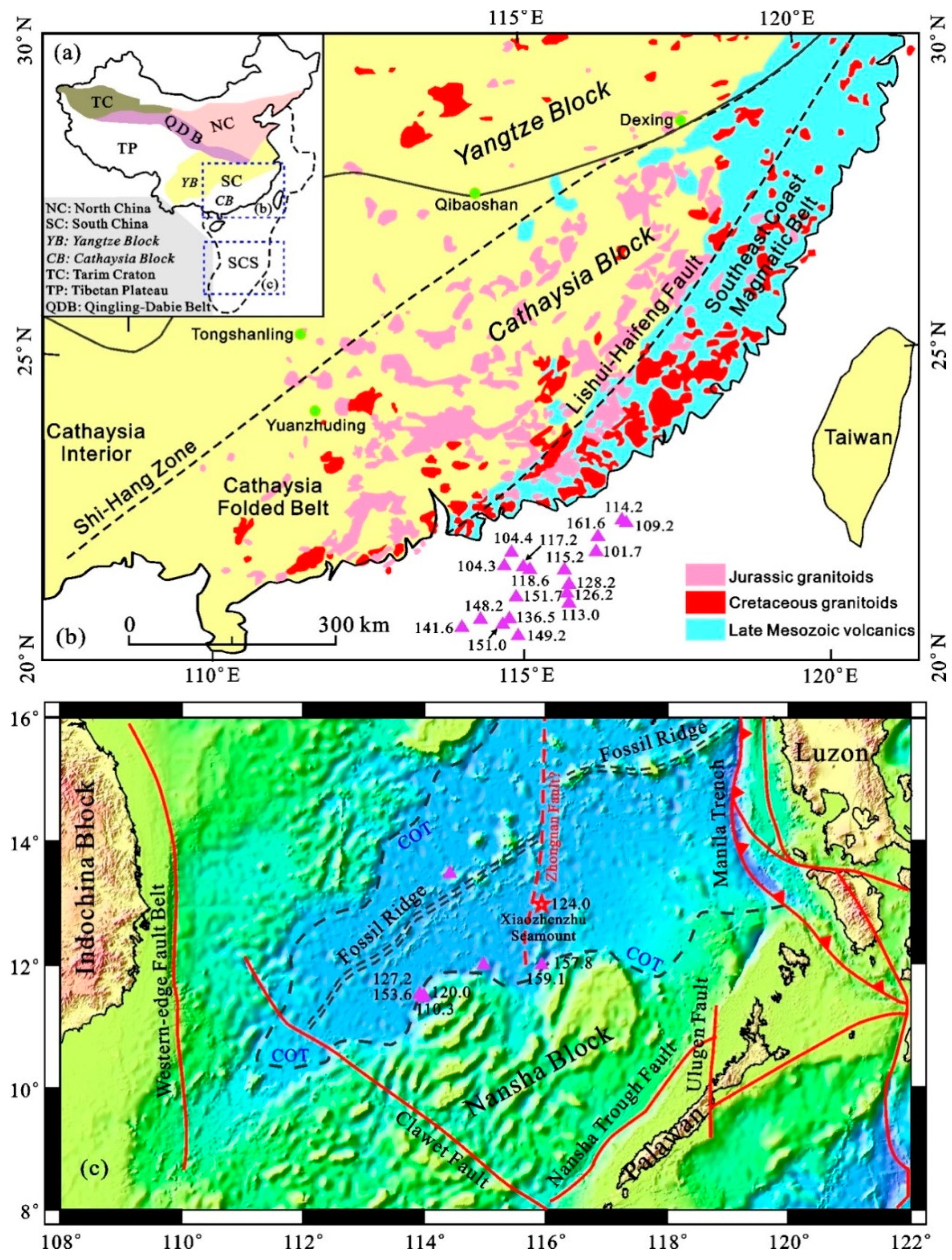
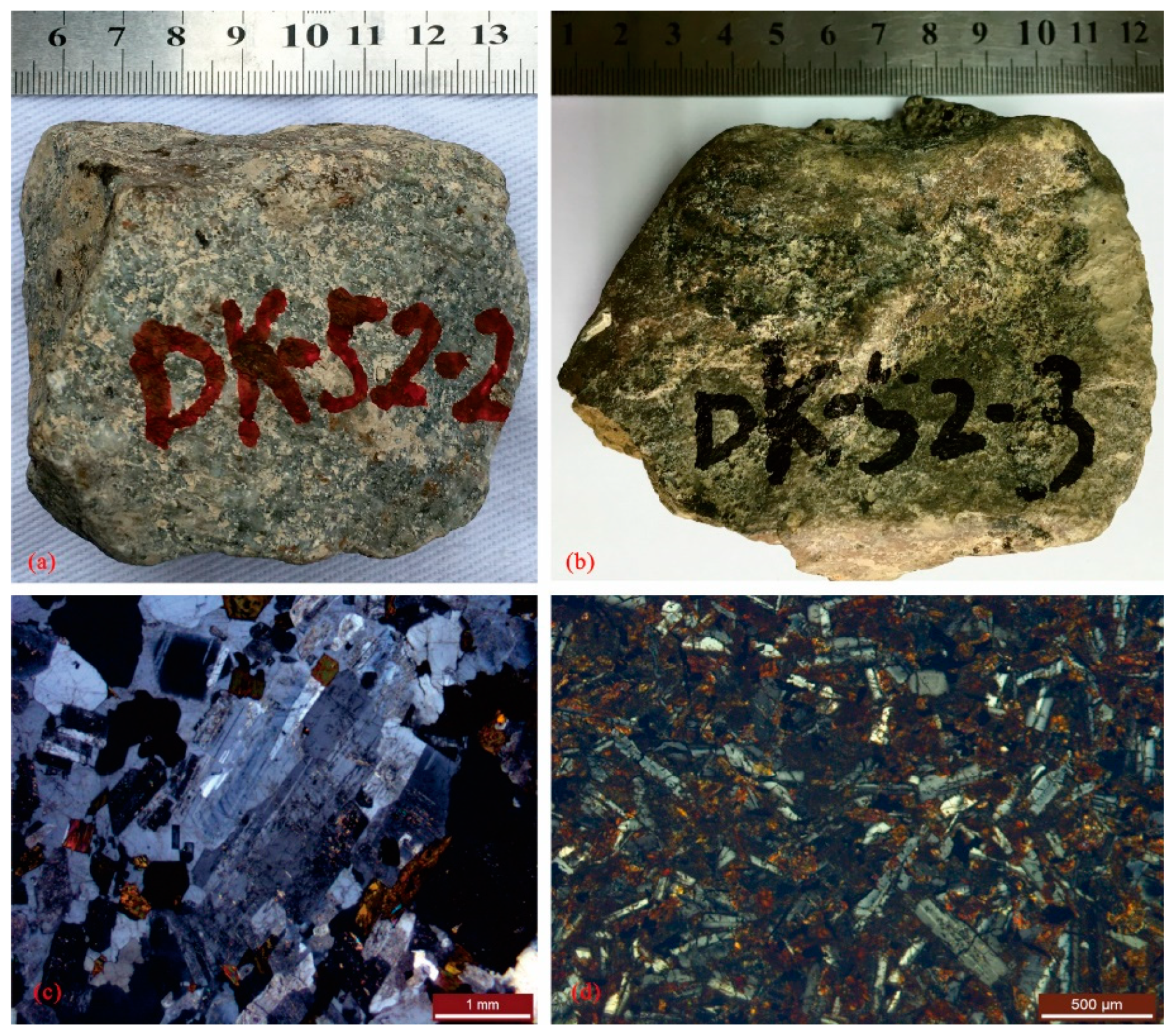
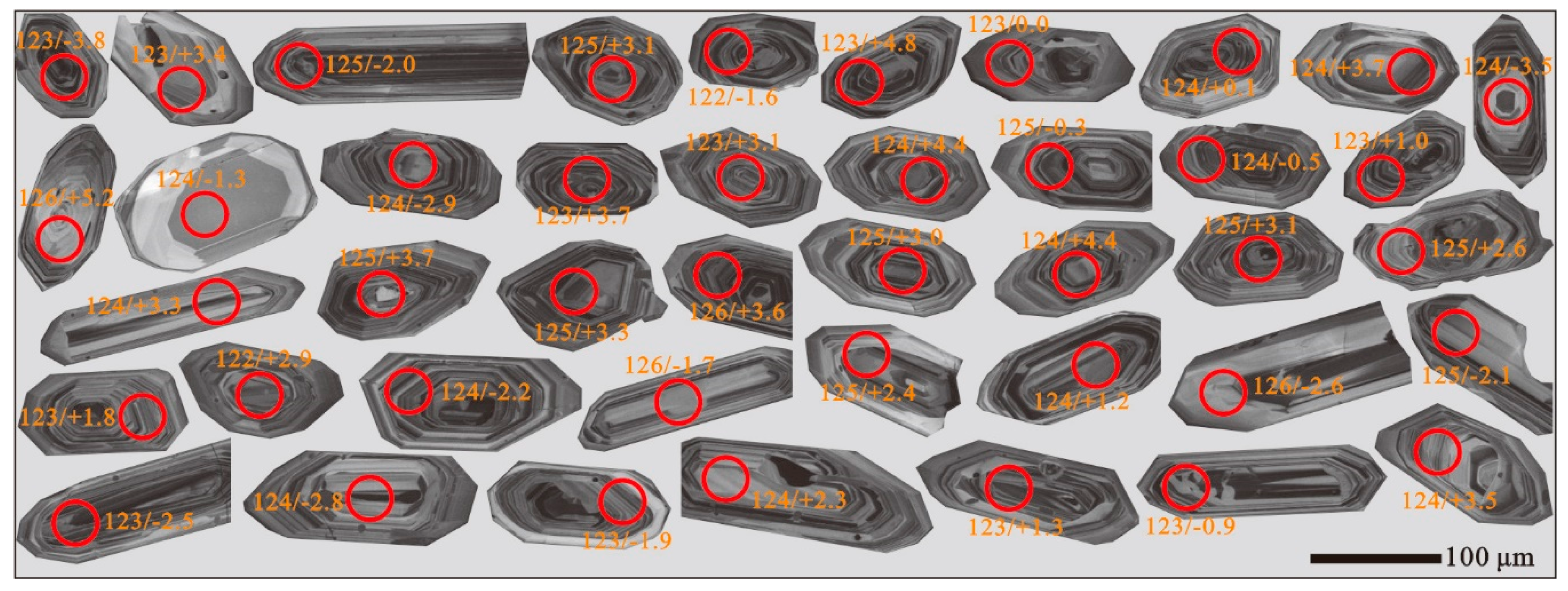
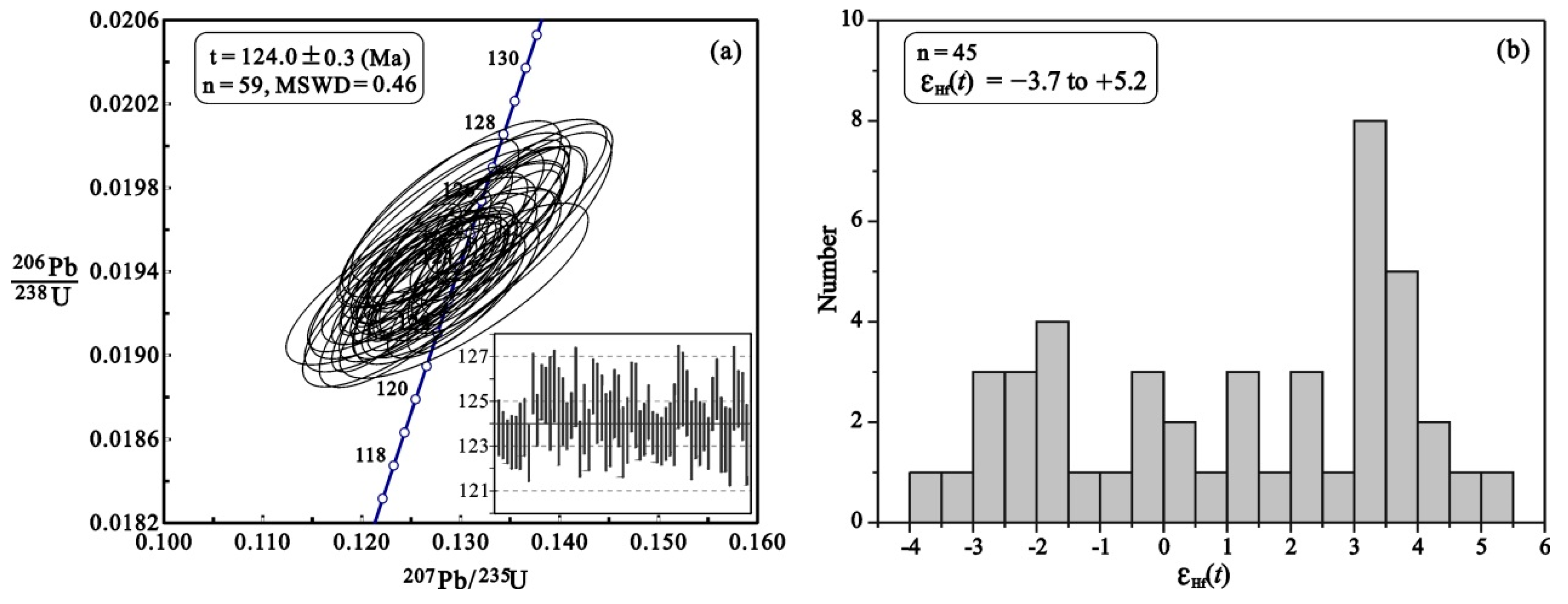
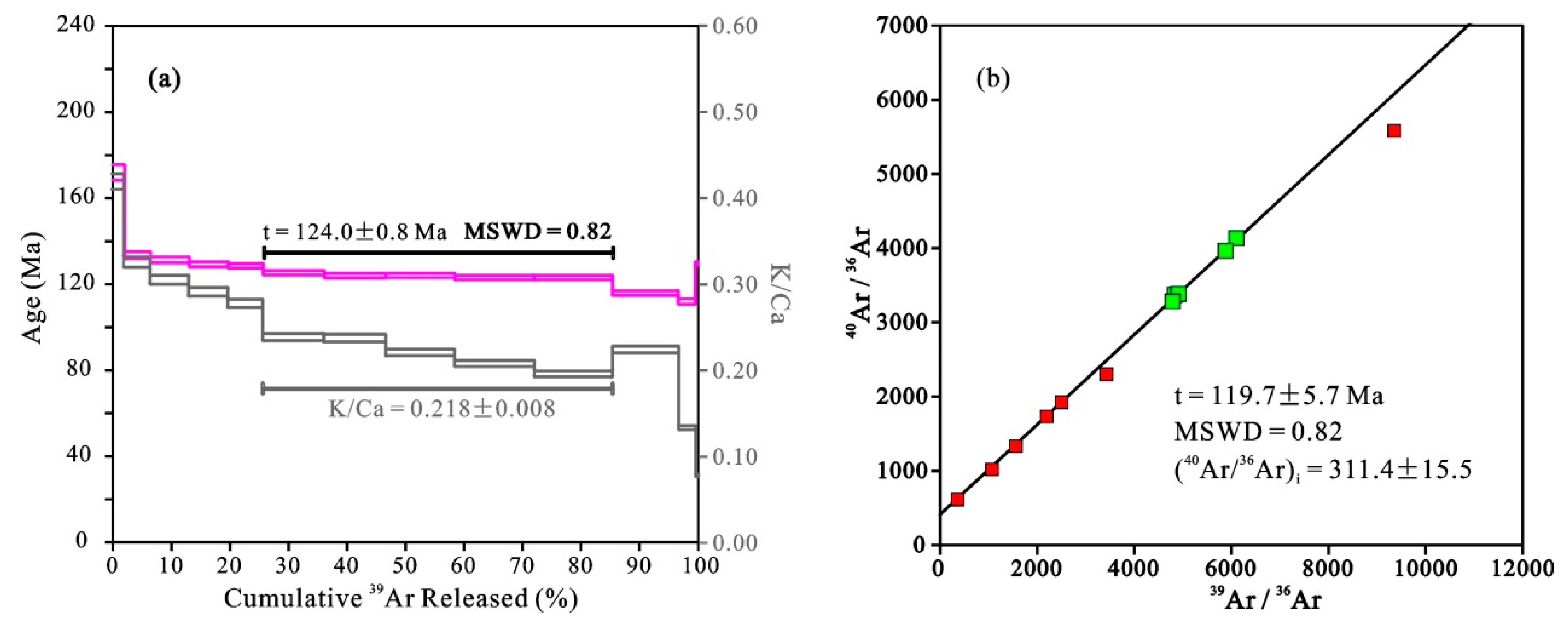
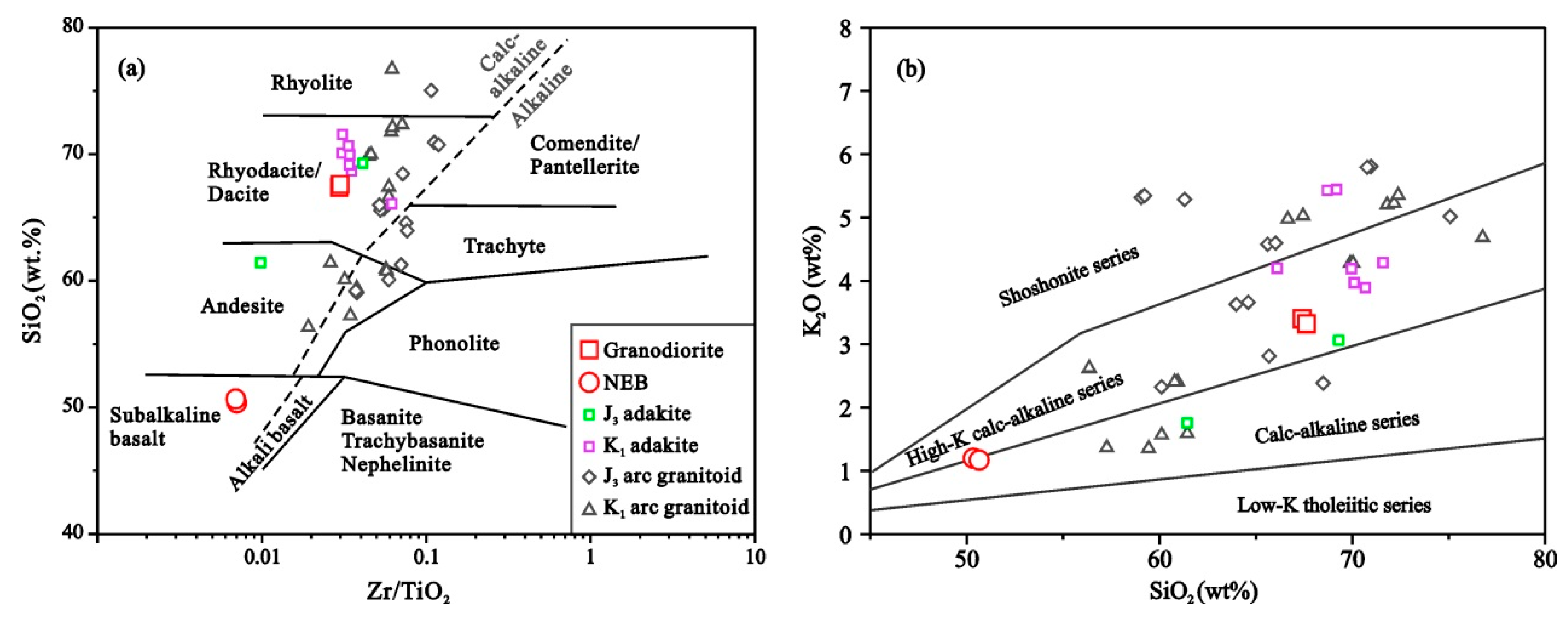
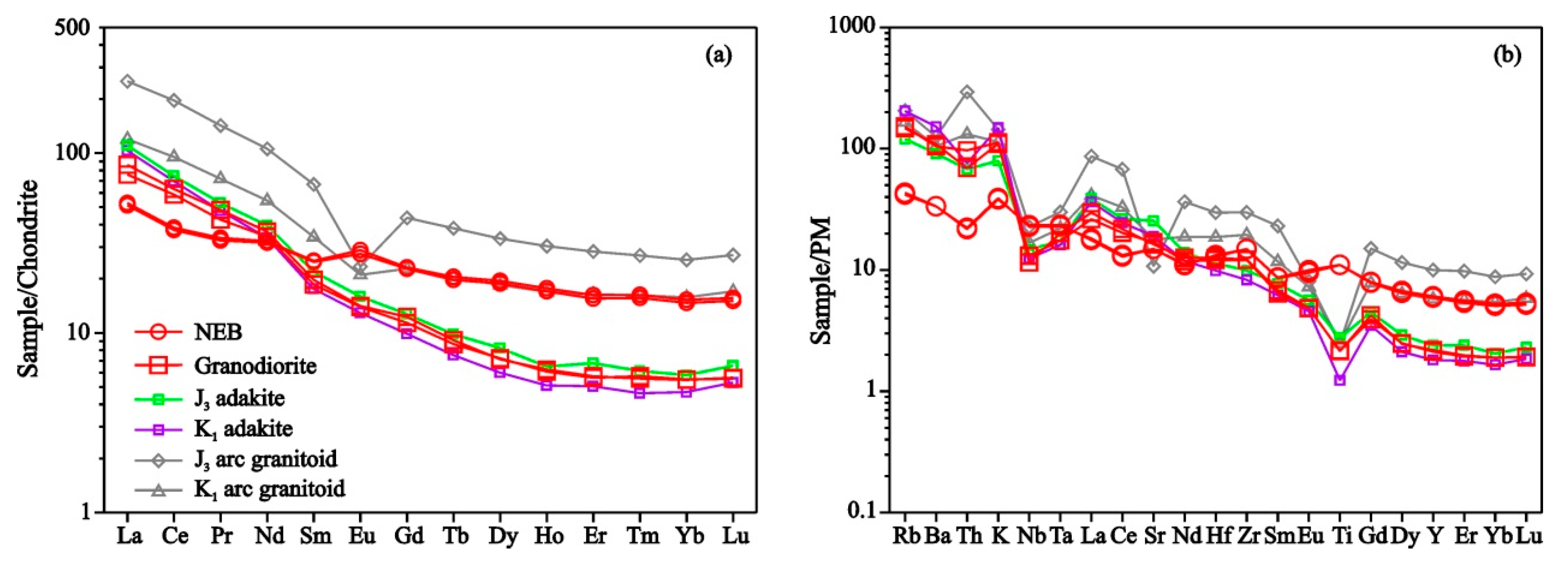
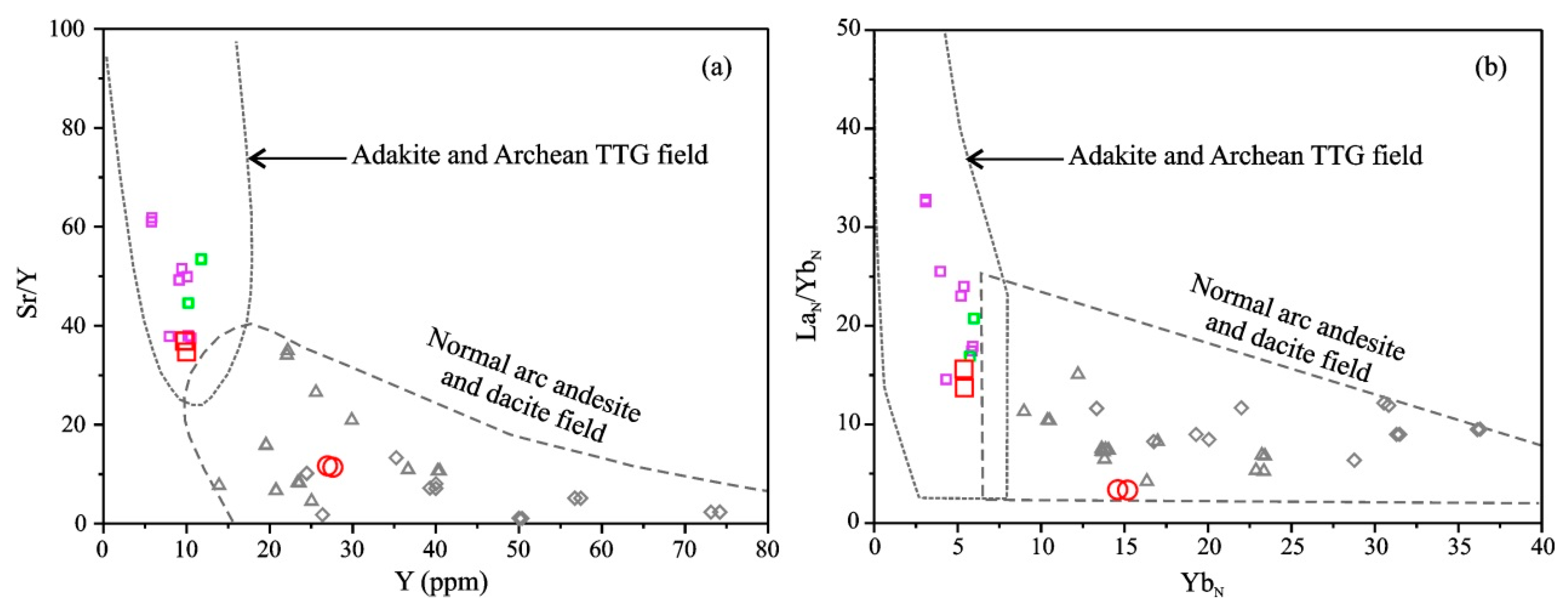
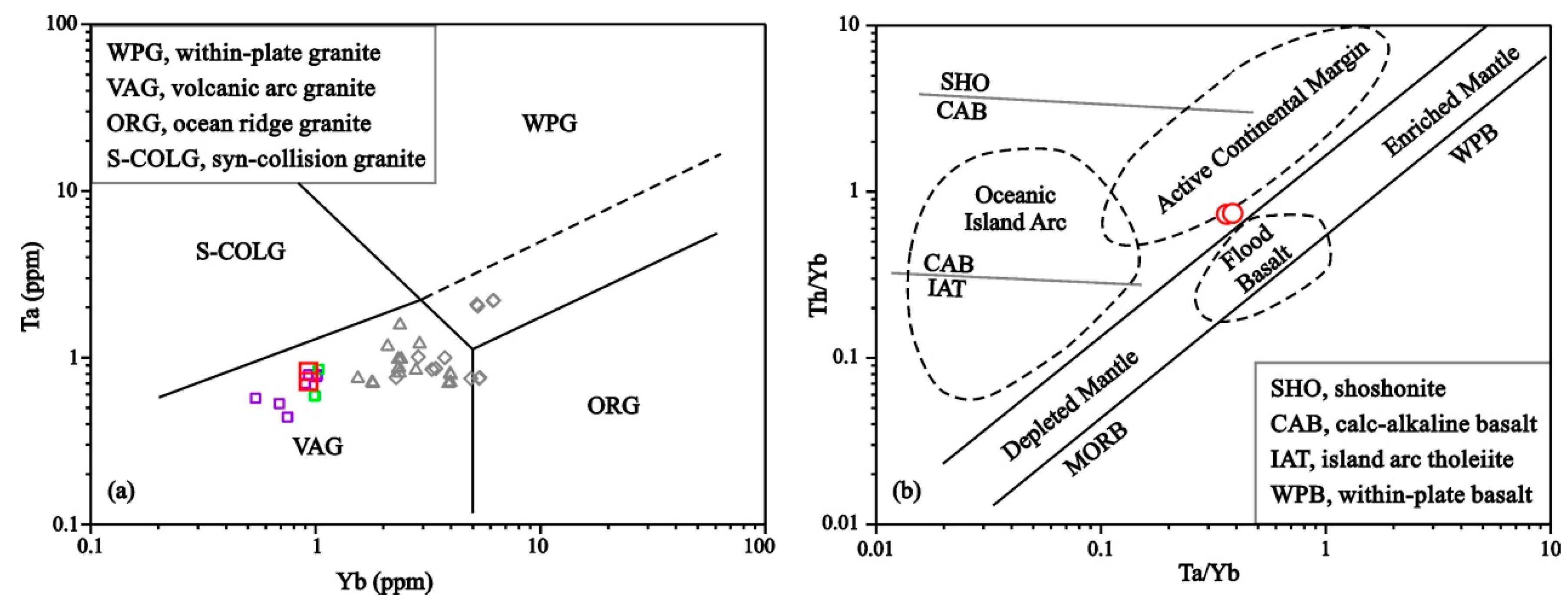
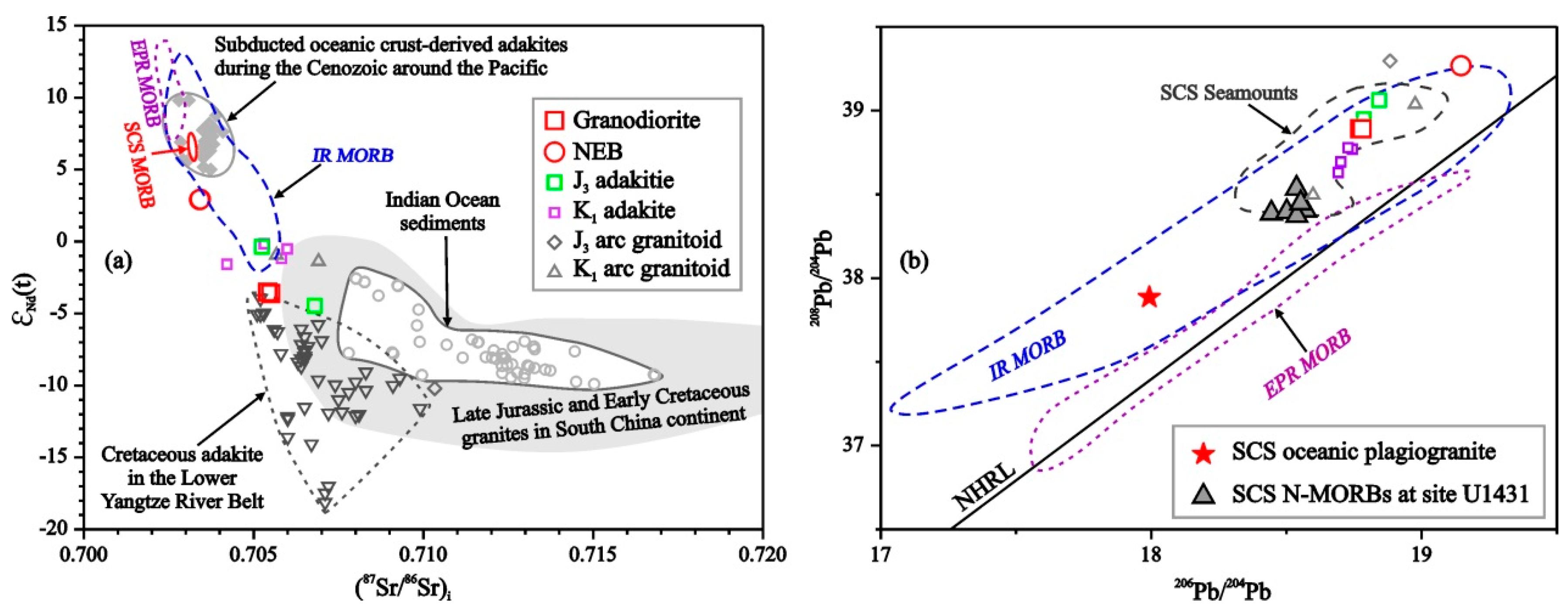
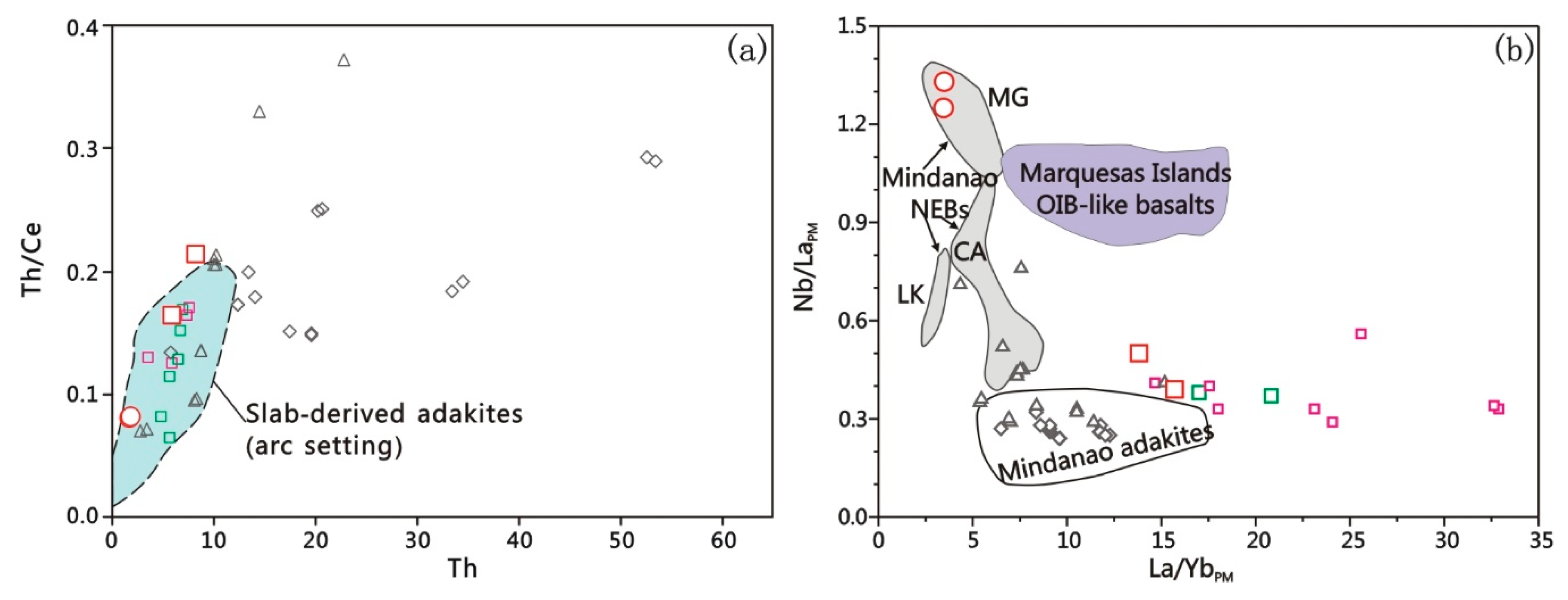
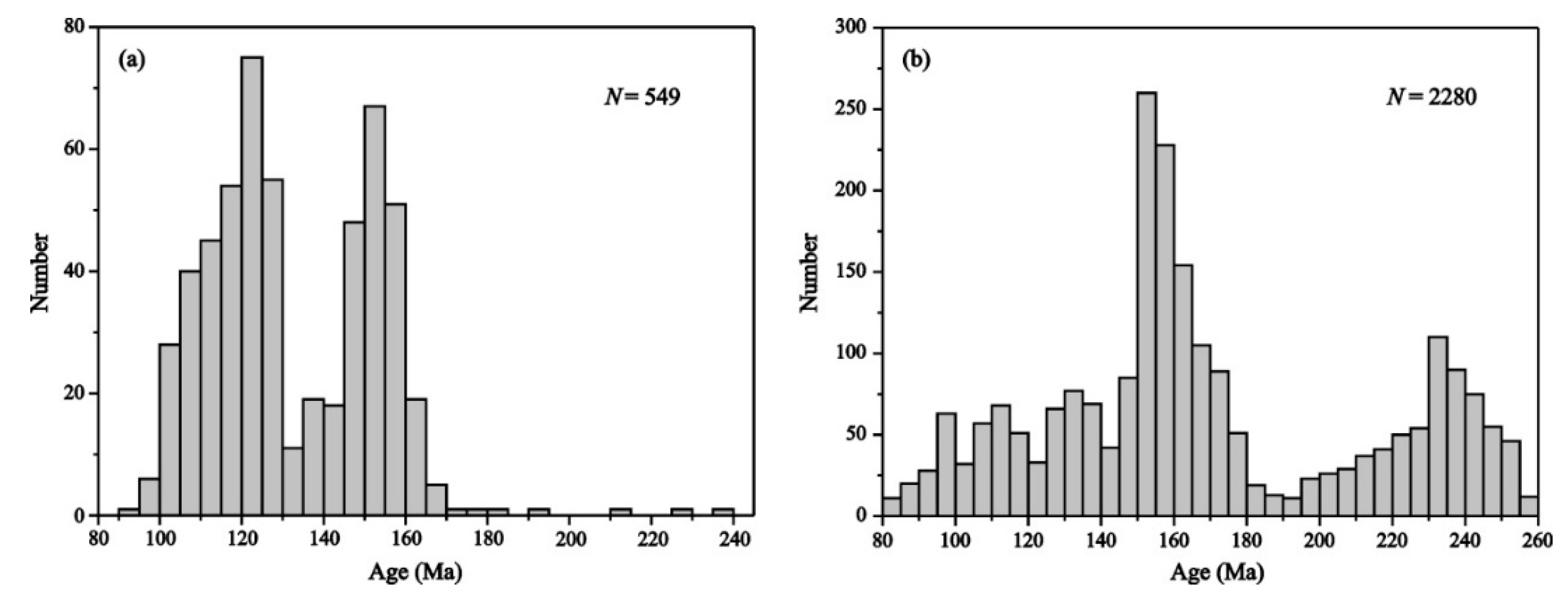
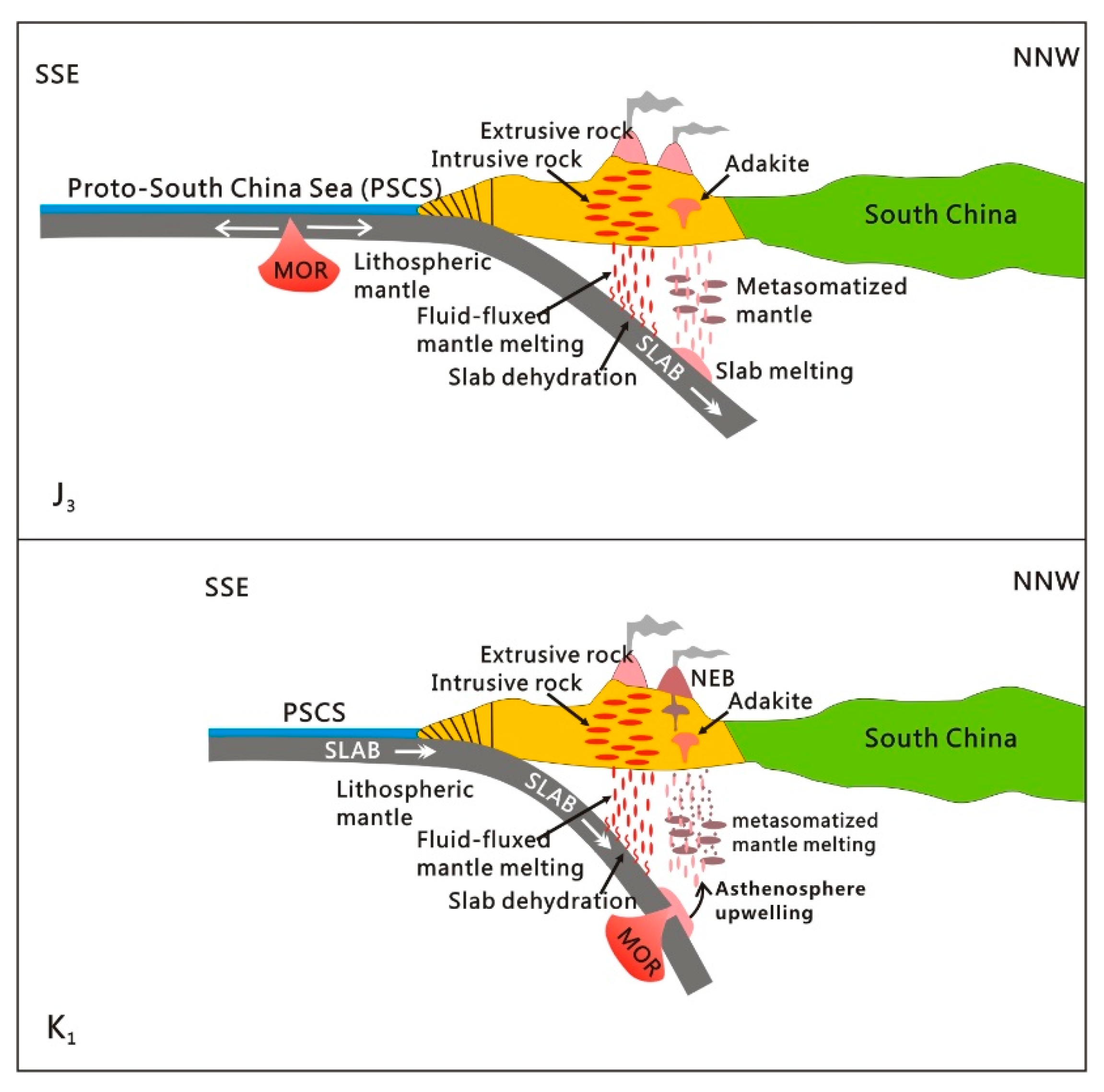
© 2019 by the authors. Licensee MDPI, Basel, Switzerland. This article is an open access article distributed under the terms and conditions of the Creative Commons Attribution (CC BY) license (http://creativecommons.org/licenses/by/4.0/).
Share and Cite
Cai, G.; Wan, Z.; Yao, Y.; Zhong, L.; Zheng, H.; Kapsiotis, A.; Zhang, C. Mesozoic Northward Subduction Along the SE Asian Continental Margin Inferred from Magmatic Records in the South China Sea. Minerals 2019, 9, 598. https://doi.org/10.3390/min9100598
Cai G, Wan Z, Yao Y, Zhong L, Zheng H, Kapsiotis A, Zhang C. Mesozoic Northward Subduction Along the SE Asian Continental Margin Inferred from Magmatic Records in the South China Sea. Minerals. 2019; 9(10):598. https://doi.org/10.3390/min9100598
Chicago/Turabian StyleCai, Guanqiang, Zhifeng Wan, Yongjian Yao, Lifeng Zhong, Hao Zheng, Argyrios Kapsiotis, and Cheng Zhang. 2019. "Mesozoic Northward Subduction Along the SE Asian Continental Margin Inferred from Magmatic Records in the South China Sea" Minerals 9, no. 10: 598. https://doi.org/10.3390/min9100598
APA StyleCai, G., Wan, Z., Yao, Y., Zhong, L., Zheng, H., Kapsiotis, A., & Zhang, C. (2019). Mesozoic Northward Subduction Along the SE Asian Continental Margin Inferred from Magmatic Records in the South China Sea. Minerals, 9(10), 598. https://doi.org/10.3390/min9100598




